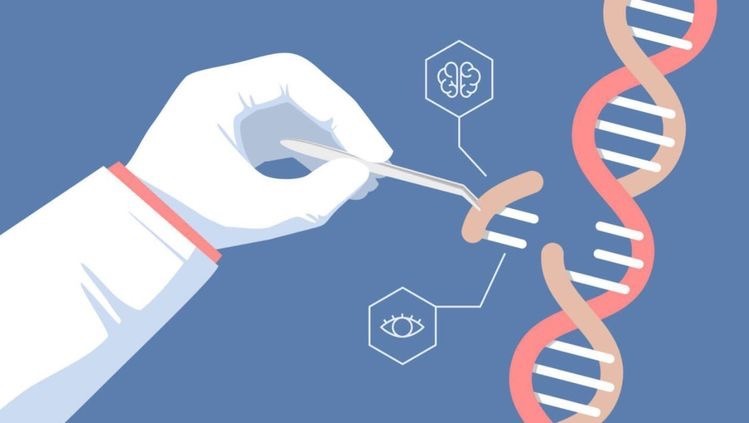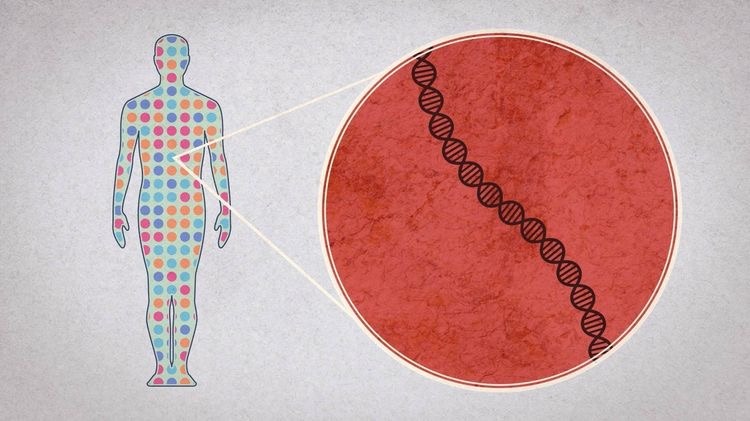DNA without protein or lipid attached present in a surrounding environment is referred to as ‘naked DNA’. It’s used in gene therapy experiments; using a vector naked DNA is incorporated into the host genome.
Our DNA is situated in the cell nucleus, on the chromosomes. It’s a complex network of DNA and protein. DNA interacts with various proteins and lipids to perform various functions. It’s an ‘intact DNA’, hence it isn’t naked.
So what is basically the naked DNA? And are there any applications of it? That’s what in today’s article I am going to explain. But before coming to the point, we have to understand several basics.
Let’s starts with gene therapy. Naked- DNA gene therapy is an emerging technology that relies on direct target nucleic acid injection into the host.
Gene therapy is the process in which a gene of interest should be incorporated in the host genome using several ways, basically having three components: Gene of interest, a vector and target site.
Previously it was believed that the naked DNA cannot be used directly for gene therapy, due to the similar negative charges of DNA and the cell surface.
The presence of phosphate on DNA makes it negatively charged, while as we all know, our cell surface (membrane) already contains negatively charged molecules. Due to the same negative affinity, the cell surface and the DNA repel each other, consequently, it does not allow DNA intake.
See the figure below,
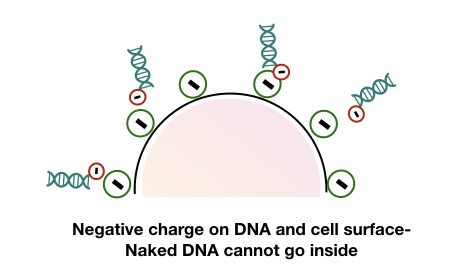
However, in the year 1990 Wolff et al reported the first case of the intramuscular injection of naked DNA into the myofibers, accidentally. The directly injected naked DNA into the myofibers of mice expressed very well. And later, a new era of gene therapy arises. Scientists are now trying to introduce DNA directly into the cell.
Noteworthy, no official naked DNA mediated gene therapy is still approved for clinical use, despite the fact, it is used in animal research often. To make the point clear we first need to understand what naked DNA is! Let’s start the topic,
Key Topics:
What is naked DNA?
A DNA without protein or lipid, freely present or present in the environment is our naked DNA. The circular purified plasmid abbreviated as ‘pDNA’ is the best example of it.
Interaction of protein or lipid with DNA indeed happens to protect DNA from degradation. And therefore naked DNA or pure isolated DNA is more prone to damage.
Terje T has defined naked DNA as, “any DNA or DNA fragments coming out of the laboratory, manufacturing unit of gene therapy experiment, present in an environment or freely present in other places is said as naked DNA.”
He has enlisted risk associated with the use of naked DNA to nature in his 136-page long content.
Certainly, the naked DNA is a concept, so we can’t define it using a single definition, here are several types of DNA consider as naked DNA,
-
- Protein or lipid-free DNA
- Purely isolated plasmid DNA
- DNA present in the surroundings
- DNA obtains by cell bursting
- Freely floating DNA
- DNA fragments escape from lab or manufacturing units
- DNA present in soil, air and water.
- Prokaryotic DNA
- Extrachromosomal or cytoplasmic DNA
The present type of DNA is either circular or linear, for example, the plasmid DNA is circular, while the DNA obtained by cell burst is usually fragments of linear DNA.
Naked DNA in prokaryotes:
You may wonder, do prokaryotes have naked DNA naturally? The answer is Yes.
Prokaryotes don’t have a nucleus and therefore their DNA is present in the cytoplasm. It’s tiny, circular DNA and does not have many associated proteins as they don’t need further packaging. And therefore the prokaryotic DNA is said to be ‘naked DNA’.
A bacterial plasmid, freely present in their cells is also a type of naked DNA.
Now you may also think, what about eukaryotes?
Naked DNA in eukaryotes:
I am answering the present question, do eukaryotes have naked DNA? But it is a bit controversial because I don’t get an answer, what I need. Let me first tell you that ‘Yes’ eukaryotes have.
Membrane-bounded organelles such as chloroplast or mitochondria have a sub-genome that is free from chromosomes. It’s circular or linear in structure and we can consider it as naked DNA.
Notedly, as we said, a cell’s cytoplasm does have fragments of DNA (naked DNA) when burst. Henceforth, we can say, eukaryotes do have naked DNA.
Transfection and transformation are two ways using which a cell transfers naked DNA.
Definition:
“The Naked DNA is free DNA without having proteins or lipids attached and can be used in gene therapy experiments.
As we said earlier, “the naked DNA is DNA lacking the outer membrane or proteinous-lipid layer.”
Applications of naked DNA:
There are two most popular applications,
- Naked DNA is usually practiced in gene therapy experiments.
- It is also used in naked DNA vaccine manufacturing
Naked DNA mediated gene therapy:
Using naked DNA in gene therapy experiments is a type of vector-mediated therapy. Here viral or non-viral vectors can be utilized to transfer a gene but most popularly the desired DNA can directly be injected into a cell or tissues using injection, gene gun or particle bombardment.
If you want more information on gene therapy, read our previous article: What is Gene Therapy? and How Does it Work?
It’s an in vivo technique to transfer a gene usually practiced for skin, cardiac muscle and thymus. It injects and expresses up to 20 Kb DNA directly. One of the great advantages of using such types of DNA in gene therapy is its capacity to penetrate into muscle and liver cells.
As it can inject DNA directly, it can’t be applicable to transfer genes in internal organs. Notwithstanding, it’s an easy and simple technique to use, having substantially higher expression in some tissues.
Scientists can synthesize naked DNA using recombinant DNA technology. PCR amplification or gene cloning makes it possible.
In summary, the process is as followed,
PCR amplification,
Extracting DNA followed by PCR amplification of the desired DNA. Purification & quantification of the interest region and injecting directly using available vectors.
Gene cloning,
Extracting DNA followed by incorporating it into the plasmid using restriction digestion or physical methods. Expressing a gene of interest and culturing transformed cells. Copies of genes are isolated, purified and used to transfer.
Though the technique is simple, it isn’t as easy to perform as what we are discussing. Researchers have to face two critical problems while executing.
First, It can’t be injected without creating pores and second, a cell can engulf and destroy foreign DNA. Our cells have a strong and well-organized defense mechanism,
“Any foreign particle when entered A cell recognizes and destroys it by the cell defense mechanism .”
The figure below explains things precisely,
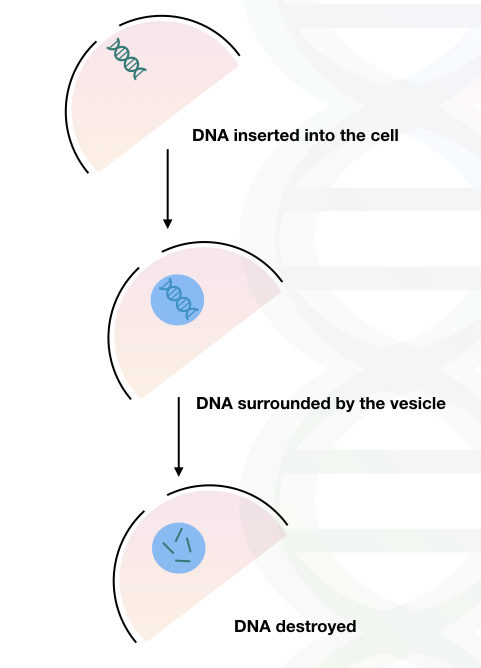
We need to make pores in our cell surface to intake DNA otherwise, because of the presence of the negative charge on both (DNA and cell surface), a cell can’t allow its entry. So how is it possible to create pores in the cell membrane? Here are several ways,
- Adding extra sequences such as promoters, polyadenylated DNA, an antibiotic-resistant gene and ORF for specific proteins increases the efficiency of the naked DNA intake.
- Due to the charge equality, the naked DNA cannot directly penetrate the cell membrane, using a synthetic capsule such as a liposome, naked DNA can efficiently transfer into the host cell. The capsule protects the naked DNA from nuclease attack.
- Techniques like electroporation, gene gun or particle bombardment help to increase the chances of DNA intake.
- Other techniques like sonication, photoporation, magnetofection and hydroboration can also be used alternatively.
As per the recent finding, modern methods like electroporation and gene gun are accurate, reliable and faster. Scientists employ the present technique for inserting genes into internal tissues as well as cardiovascular issues.
As the electroporation technique is a gem for naked DNA mediated therapy, we have graphically explained its process here:
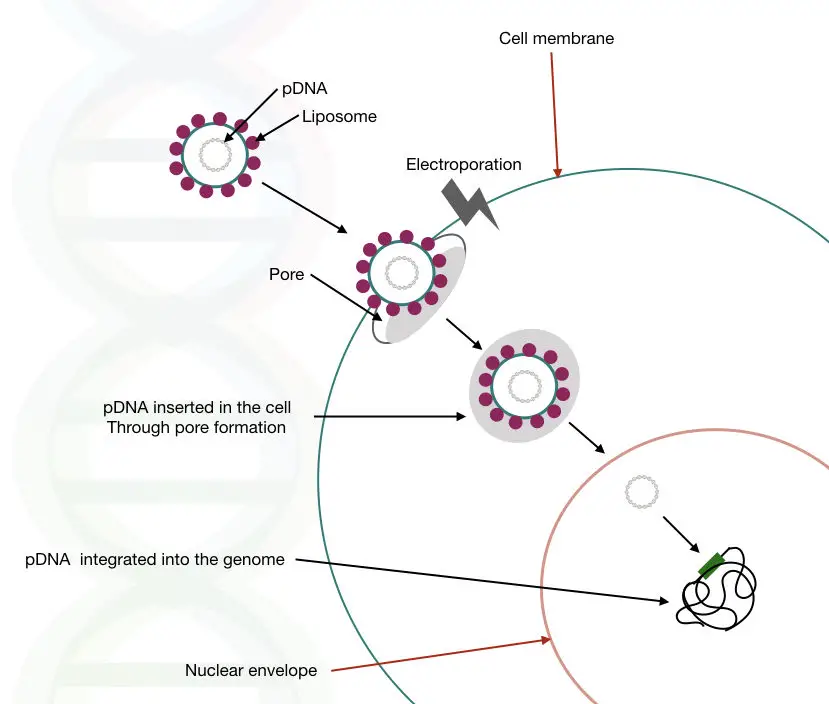
The technique is briefly as followed,
The influence of strong electric current forms pores on the cell surface followed by injecting the encapsulated DNA.
Once done, the capsule sends DNA to the cell nucleus where it incorporates into the host genome and expresses. Later on, it follows cells’ natural process, transcribes into the mRNA, moves back to the cytoplasm and translates into a protein.
Naked DNA mediated gene therapy is now entered into the clinical trial phase for the “peripheral arterial occlusive disease”.
Gene gun and particle bombardment are yet other good options for the naked DNA technique. Summary of different methods to transfer naked DNA:
| Technique | Ex vivo | In vivo | Gene expression |
| Electroporation | Yes | No | Stable after selection |
| Direct injection | Yes | Yes | Transient |
| Liposomes | Yes | Yes | Transient |
| Calcium phosphate precipitation | Yes | No | Stable after selection |
| Retrovirus | Yes | Yes | Stable |
| Adenovirus | Yes | Yes | Transient |
| Adeno-associated virus | Yes | Yes | Stable |
How does the vector carry naked DNA?
The plasmid or expression vector’s genetic material is present on a circular DNA molecule, known as naked DNA (we already have discussed it). A gene of interest can be inserted into a vector and transferred to a target cell.
Naked DNA mediated vaccines:
The idea of using foreign-pathogenic DNA to fight against infection is employed in manufacturing naked DNA mediated vaccines. In this, researchers isolate a gene from a foreign pathogen and introduced it to the target cells.
In 1993, Ulmer et al had used naked DNA as a vaccine against influenza A. Using a gene for the nucleoprotein for influenza A they had constructed an expression vector.
The DNA is directly injected into the thigh muscle of mice, and after a few weeks, antibodies were found in the samples validating the stable expression of a gene. When infected with influenza A, mice treated with naked DNA survived, contrary normal mice died.
It’s used in such a way that it can produce mild to very poor immune responses. The vaccine against AIDS is being manufactured in this way by utilizing naked DNA technology.
Notedly, none of the vaccines in this category are clinically approved yet.
Advantages of using naked DNA:
The present technology is simple and easy to use.
It can integrate a transgene (or a gene of interest) up to ~15 KB which is indeed huge.
In viral vector-mediated gene therapy, a virus can induce an immune response and infect us adversely; in comparison, the naked mediated gene therapy is safer.
The present technique when used as gene therapy is safer for the recipient and environment too.
The efficiency of gene therapy is pretty much decent. It works finely for the muscle cells and for the production of therapeutic proteins such as insulin and clotting factors.
Naked DNA absolutely has higher expression (in some tissues), infects more cells and gives good results.
Scientists can synthesize artificial naked DNA particles using recombinant DNA technology.
Disadvantages of naked DNA:
Though we have so many potential applications of using naked DNA in various fields, there are several limitations too to use it in recent times. Here we have listed a few.
The technique is yet not ready to apply in clinical trials henceforth, inherited genetic disease can’t be treated.
It has a low success rate and gene expression.
It has a lower transfection rate in comparison to viral-vector mediated therapy.
It has a negligible insertional mutagenesis rate.
Using the plasmid as naked DNA therapy may activate oncogenes and can cause cancer.
Few good things:
Scientists can test the expression vector designed for naked DNA by injecting it via tail vein in mice.
The siRNA can intravenously be injected to do gene silencing.
The immune response can be reduced by using polyadenylated sequences and less CpG rich sequences in the plasmid. It stably increases transgene expression.
Conclusion:
In summary, DNA without protein or lipid attached is naked DNA, used in gene therapy and DNA vaccines. It can transfer ~15Kb of DNA to the target genome. Prokaryotes, as well as eukaryotes both, have naked DNA present in their genome.
However, some scientists also consider free DNA present in the atmosphere, environment and DNA escape from the lab as naked DNA.
The use of non-viral vector-mediated gene transfer is a safer option for gene transfer. Naked DNA injection added a new dimension to this approach. The present technique has the potential to change the fate of gene therapy in the future. The technique is simple yet effective.
Sources:

